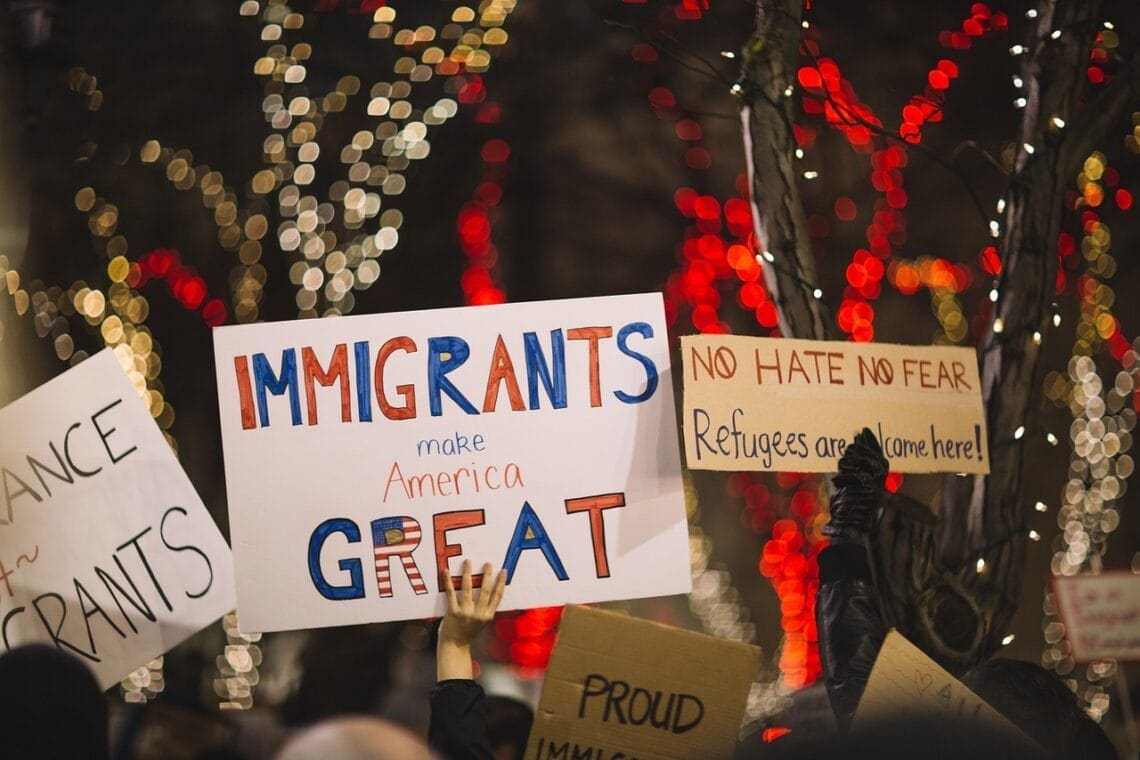
Last Updated on by Serena Zehlius
WASHINGTON — President Donald Trump’s massive tax and spending cut bill cleared early Thursday has as its centerpiece $170 billion for the administration’s immigration crackdown, helping fulfill the president’s 2024 campaign promise of mass deportations of people without permanent legal status.
The measure, passed by the House 218-214, would fulfil several of Trump’s key immigration priorities, such as bolstering border security, increasing immigration detention capacity and adding fees to legal pathways for immigration, among other things. Thousands more Immigration and Customs Enforcement officers are slated to be hired.
While most of the immigration-related provisions in the massive bill would vastly expand immigration enforcement, it also aims to limit benefits currently extended to some immigrants with legal status.
Immigrants with a lawful status, including asylum, under the bill would be ineligible to receive food assistance through the Supplemental Nutrition Assistance Program, or SNAP. Immigrants without legal status or authorization to be in the country are already ineligible for SNAP benefits, which roughly 42 million people rely on.
The bill could also cut off tax benefits from mixed-status families, in which family members have different immigration statuses.
For example, while Republicans would raise the child tax credit to $2,200 per eligible child, the bill would exclude that benefit to U.S. citizen children who are born to immigrant parents without legal status. The proposal would require that the parent applying for the child tax credit also have a Social Security number.
The 870-page megabill was passed by the Senate 51-50 on Tuesday, with Vice President JD Vance casting a tie-breaking vote.
Here’s an overview of what else the bill will do:
Immigration enforcement
The U.S. Department of Homeland Security’s Immigration and Customs Enforcement would be the highest-funded law enforcement agency in the country, at nearly $30 billion through September 2029.
Those funds would go toward hiring 10,000 ICE officers within five years. The money would also pay for retention bonuses, transportation of immigrants, upgrades of ICE facilities, detainment of families, and the hiring of ICE immigration lawyers for enforcement and removal proceedings in immigration court.
An ICE signing bonus would be given to those hired after the bill is signed into law, and as a retention bonus if an ICE agent has five years of service specifically dealing with immigration enforcement. The bill does not specify how much a signing bonus or retention bonus should be.
The Senate’s version provides ICE with added flexibility in which areas to allocate the nearly $30 billion.
DOD funding
Separately from ICE, the bill would include $1 billion for the Department of Defense to deploy military personnel for border-related operations, construction and temporary detention on military installations.
Trump in April directed several agencies to start militarizing a stretch of the southern border as he continues to intertwine the U.S. military with his administration’s immigration crackdown.
Created was a military buffer zone along the U.S.-Mexico border in Arizona, California and New Mexico. It means that any migrant crossing into the United States would be trespassing on a military base, and therefore allows active-duty troops to hold them until U.S. Border Patrol agents arrive.
National and military experts have raised concerns that militarizing that strip of land could violate the Posse Comitatus Act, an 1878 law that generally prohibits the military from being used in domestic law enforcement.
Additionally, the Trump administration last month deployed 4,000 National Guard members and 700 Marines to Los Angeles, amid major protests that arose after immigration agents began targeting day laborers at Home Depots for immigration enforcement.
Detention
The bill sets aside $45 billion for building new centers to detain immigrants, from single individuals to families. It’s a more than 300% increase from ICE’s fiscal year 2024 budget for detaining immigrants, which was about $9 billion.
Building new detention centers takes time, so private prison companies such as CoreCivic and GEO Group are likely to enter into more contracts with ICE.
Those companies have begun expanding detention capacity. CoreCivic last month acquired a 736-bed facility in Virginia and GEO this month purchased a 770-bed facility in western California.
Border security
The bill would allocate $46.6 billion for U.S. Customs and Border Protection to construct a wall along the U.S. Mexico border, as well as make any repairs. That would be more than three times what the first Trump administration spent on barriers at the southern border, at roughly $15 billion.
Some of the technology that would be added on the border includes cameras, lights, sensors, and other detection improvements. The funds would be used beginning in fiscal year 2025 until Sept. 30, 2029.
Another $4.1 billion would go toward hiring CBP personnel, until the end of September 2029. Another $2 billion would go toward retention and bonuses for CBP personnel.
The bill would also set aside $855 million for the repair of vehicles that CBP officers use. Republicans included $5 billion for upgrades and repairs at CBP facilities.
Additionally, $6.1 billion would go toward buying nonintrusive equipment to detect illicit narcotics at ports of entry along the southwest, northern and maritime borders.
Also, any immigrant without legal authorization and who is apprehended at a port of entry would be subject to a $5,000 fine.
There is currently a civil fine ranging from $50 to $250. Asylum-seekers typically surrender themselves at ports of entry.
Legal immigration pathways, application fees
The bill would give the Department of Justice roughly $3.3 billion for the Executive Office for Immigration Review to prosecute immigration matters, such as noncitizen voting – something that is extremely rare – and violations of the Alien Registration Act.
In April, DHS Secretary Kristi Noem announced that immigrants in the country without legal authorization were required to register with the agency or face jail time and a fine of up to $5,000.
The bill would also provide funding for the hiring of immigration judges, but will cap the number of judges at 800. There are roughly 700 now, amid a 3.5 million case backlog in immigration court, according to the Transactional Records Access Clearinghouse, or TRAC.
The bill would also overhaul immigration fees and application fees for immigrants seeking legal pathways, both permanent and temporary.
For the first time, there would be a fee to apply for asylum, set at $100. There are no fee waivers for nearly every new fee set or increased by the bill, except for applications dealing with unaccompanied minors. All fees would also be subject to adjustment for inflation.
Asylum-seekers who want to apply for initial work permits would also have to pay another fee of $550, something that is currently free.
For an asylum applicant wanting to renew work permits, the bill would lower the cost to $275, where it is currently $470 to renew online and $520 to mail in the paperwork.
For immigrants on Temporary Protected Status, meaning the DHS secretary has deemed the immigrant’s home country too dangerous to return to, the fee to apply would be $500. It’s currently $50.
The fee to apply for humanitarian relief would increase to $1,000, where it is currently $630.
The bill would slightly increase the initial work application fee for TPS holders and those with humanitarian status to $550, up from a $470 fee for submitting online and $520 to mail in the paperwork.
To renew those work permits, the bill would lower the cost to $275, down from $470 for online and $520 for mail.
The nonimmigrant visa, which is currently free and handled by the State Department, would now cost $250 under the bill. This visa is typically used for international students, agricultural workers and other special skilled immigrant labor.
Unaccompanied immigrant children
Some of the $2 billion in funding for DHS would go toward removing unaccompanied children under certain circumstances. That includes if the child is found by a port of entry, is not a victim of human trafficking, and does not fear returning to their home country.
The bill would also provide a $300 million fund for the Office of Refugee Resettlement, which handles unaccompanied children, to conduct background checks and home studies on any potential sponsor of an unaccompanied child.
There would also be funding to check children in ORR custody for their potential criminal and gang history. Those 12 and older would be subject to examinations “for gang-related tattoos and other gang-related markings,” according to the bill.
The special juvenile immigrant visa, which is for immigrant children who are either abandoned or abused by a parent, and allows them to apply for lawful permanent resident status, would now cost $250 under the bill, but the fee could be waived. It’s currently free.
State grants, World Cup and Olympics
The bill would also give some states $450 million for the Operation Stonegarden Grant Program, which gives funding to states and local governments that participate in border enforcement.
The bill would help states that are hosting major sporting events such as the World Cup in 2026 and the Olympics in 2028.
The bill allocates $625 million for security and other costs related to the FIFA World Cup and $1 billion for security and planning costs for the Olympics, which Los Angeles is hosting in 2028.
This post contains content that was first published on Georgia Recorder and republished here under a Creative Commons License. Read the original article.


